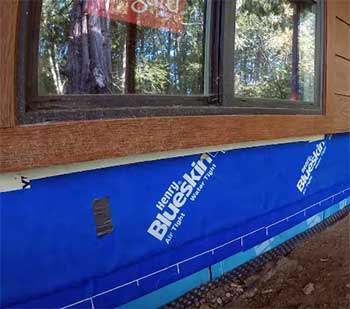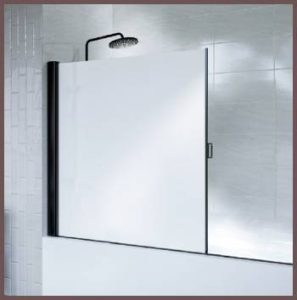In the realm of construction, the battle between housewrap giants, Blueskin VP100 and Tyvek, is a subject of heated debate. Each of these products promises superior weather barrier capabilities, but how do they stack up head to head? Let’s dive into the details.
A Brief Comparison Table
| Features | Blueskin VP100 | Tyvek |
| Material and Design | Made of a rubberized asphalt compound integrated with a high-density polyethylene film | Made of nonwoven, non-perforated sheet of flash-spun high-density polyethylene fibers |
| Installation | Self-adheres to the sheathing, no fasteners needed but more labor-intensive | Requires mechanical fasteners for installation, easier and quicker to install |
| Breathability (Perm Rating) | High perm rating of 12 | Generally has a perm rating between 30 and 60 under laboratory conditions, but this can vary in real-world applications |
| Durability | High durability and tear-resistance | Reliable and durable, but generally less tear-resistant than Blueskin |
| Cost | More expensive due to enhanced features | More affordable, making it a popular choice for many projects |
Housewraps 101: A Brief Introduction
To appreciate the contest, we first need a quick primer on what housewraps are and why they’re important. Housewraps are protective materials that go between the siding and the sheathing of a house.
They’re like the unsung heroes of a building, bravely battling against air and water infiltration, while also letting moisture escape. Imagine them as a raincoat for your house, keeping everything dry and snug inside.
The Blueskin VP100 Story

Now, meet the challenger: Blueskin VP100, a self-adhered water-resistive air barrier membrane.
Blueskin VP100 has its roots deep in innovation, presenting a compelling case for its position in this competition.
One of the primary advantages of Blueskin is its self-adhesive property.
This means no fasteners are necessary, reducing the number of potential leak points.
It has an impressive perm rating of 12, allowing for excellent moisture breathability.
Blueskin VP100 also boasts superior resistance to tears and damage, ensuring long-lasting durability.
But it’s not all sunshine with Blueskin. On the downside, its application is more labor-intensive, and any installation errors could compromise the entire system. Moreover, it comes with a steeper price tag compared to Tyvek, which can be a deal-breaker for budget-conscious projects.
Tyvek: The Contender in Focus
On the other side of the ring stands Tyvek, a classic choice in the housewrap market. Its reputation has been built on its long history and proven performance. Tyvek wraps are known for their exceptional durability and superior water and air resistance.

Moreover, Tyvek is known for its affordability, which makes it a favorite for many contractors.
It also has a strong network of trained installers, ensuring quality in application.
However, Tyvek also has its fair share of challenges.
Unlike Blueskin, Tyvek requires fasteners, which means additional leak points. Its durability, although commendable, isn’t as high as Blueskin’s.
And although it allows for moisture breathability, its perm rating is generally lower than that of Blueskin VP100.
Blueskin VP100 and Tyvek Housewraps: Pros and Cons
Let’s break down the pros and cons a bit further:
Pros of Blueskin VP100
- Excellent water and air resistance
- High durability
- Self-adhesive, no fasteners required
- High perm rating of 12
Cons of Blueskin VP100
- More expensive
- Installation can be labor-intensive
Pros of Tyvek
- Proven performance
- Excellent water and air resistance
- Affordable and widely available
Cons of Tyvek
- Requires fasteners, introducing potential leak points
- Lower perm rating compared to Blueskin
Key Differences Between Blueskin VP100 and Tyvek Housewraps
As we’ve traversed the landscape of housewraps, it’s clear that Blueskin VP100 and Tyvek each bring unique characteristics to the table. Let’s unpack these differences in detail to help you make the best choice for your project.
- Material and Design
The first key difference lies in their material and design. Blueskin VP100 is a self-adhered water-resistive air barrier made of a rubberized asphalt compound, integrated with a high-density polyethylene film. This innovative design allows for high durability and tear-resistance.
On the other hand, Tyvek is a nonwoven, non-perforated sheet of flash-spun high-density polyethylene fibers. This design offers reliable performance and is more traditional in the world of housewraps.
- Installation
Installation is another crucial point of divergence. Blueskin VP100’s self-adhesive property removes the need for fasteners, reducing the number of potential leak points. However, this self-adherence can make the installation process more labor-intensive and demanding in terms of precision.
In contrast, Tyvek requires mechanical fasteners for installation. While this increases the potential leak points, the installation process is generally quicker and less complex.
- Breathability (Perm Rating)
Breathability, measured by the perm rating, is a vital factor in housewrap selection. Blueskin VP100 takes the lead in this department, boasting a perm rating of 12. This high rating indicates that Blueskin allows for excellent moisture breathability, which is crucial in preventing moisture buildup inside your walls.
Tyvek, while still having commendable breathability, generally has a lower perm rating than Blueskin VP100.
Although Tyvek’s perm rating can vary, it usually falls between 30 and 60 US perms when tested in laboratory conditions, suggesting more breathability than Blueskin, but it’s worth noting these values can change under real-world conditions.
- Cost
Lastly, the cost factor cannot be overlooked. Blueskin VP100 tends to come with a higher price tag compared to Tyvek, largely due to its enhanced features like self-adherence and high durability.
On the flip side, Tyvek’s affordability has made it a popular choice among contractors and homeowners alike.
Also Read: Differences Between HydroGap And Tyvek Housewraps.
Frequently Asked Questions (FAQ)
This depends on the specific needs of your project. Blueskin boasts a high perm rating and excellent durability but comes at a higher cost. Tyvek, on the other hand, offers excellent performance at a more affordable price.
“Better” can be subjective in the world of housewraps. Different products excel in different areas. While Blueskin VP100 might be better in terms of durability and perm rating, Tyvek has a stronger foothold in affordability and widespread availability.
Blueskin VP100 has an impressive perm rating of 12. This indicates that it has excellent moisture breathability, allowing any trapped moisture within the building to escape.
Again, this depends on your specific needs. Both Blueskin VP100 and Tyvek are excellent choices, each with its unique strengths. Assess your project requirements, budget, and preferences to decide which one suits you best.
Final Thoughts
The battle between Blueskin VP100 and Tyvek is not a matter of absolute superiority. It’s about what works best for your unique building project. Both products have their merits and drawbacks, and it’s up to you to weigh these against your needs.
So, whether you’re a seasoned contractor or a homeowner embarking on a DIY project, make your choice wisely. And remember, the best housewrap is the one that best meets your project’s specific needs.



